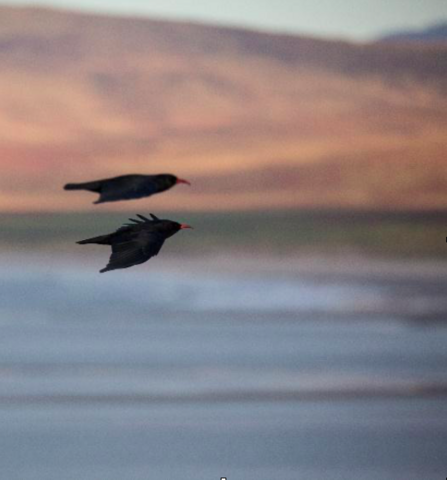Under ordinary circumstances, I would be sitting down to write this, my first blog, armed with tales and updates from the reserves. As it is, like most of us, I am spending a lot of time at home and consequently wondering how much of this blog I can devote to the jackdaws nesting in the chimney of the house opposite – #dwtWildatHome
Getting to know the neighbours

Neighbourhood jackdaw – P. Catton
Prior to joining Durham Wildlife Trust, a whole ten days before lockdown began, I was fortunate enough to have lived and worked as an RSPB warden in the Hebrides on the Isle of Islay. Conservation of Red-billed Chough was my focus, and every year I would monitor the breeding behaviour, success and productivity of these charismatic birds. For chough conservationists, the jackdaw is something of a troublesome species. Despite being corvid cousins, jackdaws are prone to stealing nests from chough. So, although the plight of Scottish chough cannot be blamed on jackdaws, they are certainly not helpful to the recovery effort.

Red billed Chough (c) P .Catton
It is therefore nice to be able to observe these city jackdaws going about their business, without having conflicted feelings for the welfare of chough. And the bonus is, jackdaws are pretty awesome in their own right.
Social and intelligent, jackdaws have been noted for their ability to recognise human faces and individuals. It is an extraordinary capability that only a small number of animals possess. Furthermore, a study by the University of Exeter showed jackdaws communicate information about ‘dangerous’ human individuals to other jackdaws, so they learn from one another without requiring risky first-hand experience. Most amazingly, studies have shown that jackdaws can follow and interpret subtle human eye movements in order to receive directions to food – a level of communication that, to date, has not been seen even with primates.
I do not know if the jackdaws I am keeping tabs on are that smart, but so far, they seem to be doing alright. At the beginning of lockdown, the pair were busy preparing their nest, but as the weeks have rolled by, the female is conspicuously absent. Most garden birds delay incubation until they have laid all their eggs, ensuring that hatching is synchronised, and all the chicks are the same age and size. However, jackdaws, like some owls, are known to utilise asynchronous hatching. The female will generally lay an egg every couple of days until she has a clutch of between 3 and 8 eggs, but she will usually start incubating the eggs before she has finished laying. Incubation is what triggers development of the embryo within the egg, meaning there could be several days age difference between the oldest and youngest nestlings.

Jackdaw (c) Bengt Nyman
This has a direct bearing on younger chicks’ chances of survival, and it will be heavily dependent on how good conditions are for foraging. In plentiful years, the family prospers, in bad years, they cut their losses and only the oldest and strongest survive. Although the fate of the younger chicks may seem like something of a cold insurance policy, do not judge the jackdaw too harshly. Anthropomorphically speaking, they are great big softies. Renowned for being monogamous, it is less widely known that even non-breeding and same sex birds will form and maintain strong pair bonds, whether at an early stage at the expense of breeding or as a result of being widowed. It seems they need companionship.
Females incubate each egg for 17-20 days, so by my calculations there should now be some young chicks in my neighbour’s chimney. To reduce the risk of infection and attracting predators, adults keep the nest area clean and tidy by removing faecal sacs. These are the equivalent of chick poop bags and if I am lucky enough to see them being removed, it will confirm my timings.
As it is, I am watching a single male bird make regular forays out for food and invariably returning within 15 to 20 minutes to provide for the hungry occupants. Chicks should have enough downy feathers by 12 days to enable the female to leave them unattended. At which point she will join these foraging trips, helping me pin down the timeline a little further. Fledging normally occurs around 32 days, so my money is currently on 27th May. I am looking forward to it already.
So, what is my message with this blog? Do I even have one? Possibly, and I think it is simple one. At the risk of preaching to the converted, enjoy what is in front of you. Perhaps you are lucky enough to live near a nature reserve and can take a stroll as part of your daily exercise, but if not, look closer to home. There is a bound to be a nature drama unfolding on your doorstep, why not take the time to watch it unfold: Wild@Home
Take care.
Phill
Oh, by the way, I mentioned I had just started with the Trust, I am the new Living Landscapes Officer (North). In a nutshell, that means I work alongside the team and many dedicated and passionate volunteers to create places where nature can thrive, and people can get to enjoy it. If you are interested in supporting us, either by volunteering or by becoming a member, please get in touch: mail@durhamwt.co.uk

